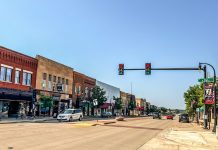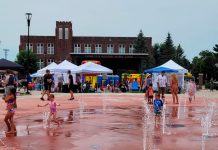Third Birthday for Kodiak Bears at Wildwood Zoo
2/14/18 – Since their arrival at the Wildwood Zoo in 2015, Kodiak bears Munsey and Boda have become favorites among adults and children alike. They will turn three years old on February 21.
Currently, Boda weighs about 820 pounds and Munsey is smaller at 760, compared to 515 and 555 a year ago. They’ve also gained a few inches in height and stretch about 7.5-8 feet tall.

The bears won’t be full grown until they reach five or six years of age, and after that would continue to gain weight at a slower pace. Zookeeper Steve Burns said the average size of a male kodiak bear is 1,700 pounds and 10-12 feet. The largest-known Kodiak Bear resided at Dakota Zoo in Bismarck until the late eighties and weighed 2,100 pounds.
Diet is important when keeping a Kodiak Bear healthy, and currently the bears eat about 35 pounds of food each day. That includes six pounds of meat, thirty cups of bear chow, and about five gallons of produce.
Inseparable as cubs, the bears are still close. “They do spend some time apart, more than when they first arrived,” said Burns. “They are more independent, but still, they enjoy spending time with each other.”
To the delight of onlookers, the bears like to play together, whether it’s swimming in the pool or roughhousing.
“They always love wrestling,” said Burns. “They’re constantly pushing each other around, bears being bears.” Munsey and Boda also enjoy bark stripping and have a lot of fun dragging logs around. Due to their growth, there is one activity they can’t physically do anymore.

“One of the big changes in the last year is that they’ve basically reached a size where they can no longer climb trees,” said Burns. While the bears used to be able to climb thirty feet, then later a few feet, they are no longer able to support their weight to hoist themselves up the branches.
But there is still plenty for the bears to do in the state-of-the-art exhibit, and zookeepers work to create an enriching environment.
“The exhibit is so large and natural, that it’s easy to all back on the excuse that we don’t have to do as much because their environment is enrichment enough,” said Burns. “We’re challenging ourselves to avoid that mindset.”
Some of the ways the zoo does enrichment is to change up the exhibit, put out novel things for the bears to check out, and present food in different ways, whether it’s frozen or stuck inside a log.
The zoo looks for creative ways to create enrichment opportunities, whether it’s a paint brush holder or a Christmas tree with “presents.” Zoo employee Sarah Storandt is currently creating a beehive-type structure that can be sweetened up with honey, peanut butter, and fruit.
The bears will have to figure out how to access the treats. “That will really challenge their brains and their dexterity,” said Burns.

People can expect more paintings called “Kodiak Originals” to be auctioned off at future events. Last year, a pvc paint brush holder allowed the bears to paint by batting at the brush from inside their cages while someone holds the canvas.
“It’s an enrichment that the bears enjoy, so we’ll do that again,” said Burns.
While the bears are healthy and thriving today, a big scare came near the end of summer. In mid-August, Munsey appeared to be lethargic and refused to eat his morning meal. Given that one of the bears had ingested a corn cob and exhibited the same symptoms earlier in the year, the zookeepers suspected an intestinal impaction.
After several days of refusing food, a vet was called in to do imaging. “Our vet did an ultrasound and we didn’t see anything, but it’s very hard to see the entire GI tract on a bear, so we couldn’t be entirely sure there wasn’t something we missed,” said Burns.
With nothing noticeably wrong, they adopted a wait-and-see approach and to their relief, Munsey seemed to bounce back to normal, playing with Boda as usual. Whatever was causing him discomfort appeared to have passed through his system.

But Munsey took a turn for the worse two days after the vet visited, arrangements were made to transport the bear via a crate down to Madison, where about fifteen vets of every specialty were waiting to examine him.
Even with thorough imaging, the vets were unable to pinpoint anything wrong. They decided to do surgery and feel the intestine inch by inch for any obstruction.
“We just decided that we had to take every possible option at the time to make sure that he was going to be okay,” explained Burns.
Even then, no obstruction was found. With the knowledge that no major problem had been found but feeling unease over not having an answer, Munsey was driven back in the middle of the night and closely monitored. He was separated from his brother Boda for six weeks to avoid opening up his stitches. Luckily, the design of the exhibit meant Munsey could spend time outside in the primary exhibit while Boda lived in the woods section.
Munsey recovered and passed bits of rubber and canvas: materials from a firehose, a common form of enrichment for zoo animals due to its durability and multiple uses.

“That was the worst scare of my professional life for sure,” Burns reflected. “But he is fully recovered. Within a few months of the surgery, he had gained back the weight, plus more since. There’s really no long-term effects of the surgery or the illness that we can see.”
After much time, effort, and many phone calls, Munsey made it through his health scare. The zoo, however, now strictly avoids giving firehoses to the bears as a form of enrichment.
While Munsey weighs less than his brother Boda, this difference is more to do with his unique body structure than the health issue.
“Just like human siblings, everyone varies,” said Burns. “He was always a little smaller than Boda. During that health ordeal, obviously the difference in their weights increased a little, but I don’t think it’s going to have any permanent effect.”

Not ones for hibernating in captivity, the bears are still active at the zoo during the winter and remain favorites among visitors and to the community as a whole.
“I think from the very beginning, the bears worked their way into the fabric of Marshfield. There’s so many people I talk to that have created or built relationships with the bears already, and it’s only been three years,” said Burns. “Bears in general are such cool animals. They’re animated and fun to watch, and there’s a lot you can learn from them.” Previously, two grizzly bears named Cubby and Ms. Grizz were stars of the zoo.
After their mother was illegally shot in Alaska, the cubs were rescued and nursed back to health.
“Munsey and Boda specifically, they come with such a unique rescue story and history, that I think people really latched on to that already, not to mention the rarity of having Kodiak Bears in captivity. I think people recognize that and realize how special it is.”
Visit Munsey and Boda at Wildwood Zoo during Winter hours from 7:30am-2:30pm daily through March 31. Donate to the Wildwood Zoo here.
Photos for this story provided by Daryn Bahn.
















